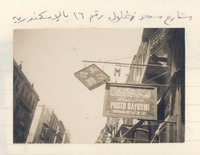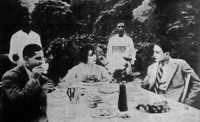Studios

Studio Bayoumi, 16, Saad Zaghloul Street by Ramleh Station. Handwritten script by Dawlat Bayoumi, 2006

From left to right: Mohamed Said Hosni, Ehsane Sabri (owner of Sawsan film) and Hosni Ibrahim Bey in The Victim
The early days of cinema in Egypt, as was the case with its counterpart worldwide, saw mainly the production of short films, actualities, newsreels, documentaries and educational films. Starting from 1929, the production of this genre of film took second place when compared to the production of the longer genre of feature films. As the photographers who were shooting those films were Alexandrians, the first Egyptian studios were, naturally, located in Alexandria.
At first, the Alexandria studios were experimental and basic. Compared to the others, the SITCIA studio seems to have been a sophisticated built-to-purpose studio spread over 600 square metres in Hadra, but it reflects all the ingenuity and improvisations of those early days. In the absence of electric light for cinematographic photography, filming was entirely dependent on natural light and sunlight, and thus photographers had to make the best use of both. So the SITCIA plateau was all glass, and the panes were covered with black or white curtains. Next to the studio was a lab to develop and print the films, and rooms for montage. Togo Mizrahi’s studio was a converted cinema (Dar Cinema Bacos) on Hagar el Nawatiya Street in Bacos, and as it had no lab, Mizrahi used to develop and print his films at Orfanelli’s studio. It was customary among the early filmmakers to live either next to the studio, as Bayoumi did, or to use part of the house as a studio. The Lamas, for instance, used their own villa. Orfanelli started out by pitching a tent in his garden in which he filmed the indoor scenes, before moving to a larger three storey villa, using the ground floor as plateau and the upper floors for labs and offices.
The managers and owners of those studios were artists who usually took part in the making of the films produced in their studios; they acted, directed and supervised the technical and artistic aspects of their productions. A studio, in its earliest form in Egypt, was the embodiment of the whole cinematic industry. It was the space for creation and the realization of the imagination, a school for artistic technicians. It had all the makings of a production company. Every studio had its own staff of technicians who were pioneers in their different specializations. They were founded in great part by foreigners: many already living in the city, and others who sensed its potential and decided to embark there and join the action. The Lama Brothers, Alvise Orfanelli and Togo Mizrahi are only examples of such cases.
Understandably, with such a novel art still feeling its way, Egyptians were either wary or not yet steeped in the technology. Investing in it was too precarious a risk whose calculations they could not yet reckon with. The contribution of Togo Mizrahi to Egyptian Cinema is of a magnitude whose full acknowledgement and recognition cannot be stressed enough. Mizrahi, who had a Ph D in Economics, took a risk and never ceased to experiment with the business and the genre.
The long list of names testifying to the number and eclectic mix of nationalities who worked in the early days of cinema in Alexandria is as touching as it is impressive. That many of those would also gamble with investing in a new and untested medium suggests that capital was spent in good creed and that foreigners and Egyptians alike felt at home in a city that had room enough for a wide and varied network of visitors and residents whose sense of integrity remained unthreatened by the blowing winds. That Josephine Sarkis was sometimes Badreya Raafat or that Togo Mizrahi was also known as el Meshriqi with no effect on status, assimilation and integration, or for that matter, box office, is a telling sign of the times.
Sweating under the same sun and studio bulbs, united and bound together by the same Alexandrian horizon framing the scene of events, a good and growing number of locals collaborated by way of technical assistance. Thus gaining much invaluable experience, many were able to carry on long after their peers were gone, forging an illustrious career as in the case of Mohamed Bayoumi the all round cinematographer, Anis Ebeid the translator, and Abdel Halim Nasr the director of photography.
With the exodus of many of the early enthusiasts, the second line of Egyptians found themselves with little more than now inadequate and old-fashioned equipment. The modesty of material left behind was understandable given the fact that a certain transience always loomed upon an industry almost begun entirely by foreigners and businessmen. A fact to which testified the films made, their subjects and the handling thereof, capitalizing mostly, for instance, on comedy and farce. Even by way of archaeology, Said el Shimi likes to mention that a camera he still uses for filming under water was made for him decades ago by the Armenian Hagop Ohan.
The advent of Talaat Harb and his creation of the banking industry and Bank Misr, heralded the beginnings of a new era in cinema. Healthy sums were invested, funds were made available, studios were modernized and an industry was officially launched. Studio Misr attractd movie makers to Cairo, but it was the outbreak of World War II in 1939 and the German bombs that made those who had lingered in Alexandria, such as Orfanelli and Mizrahi, take the plunge and move to Cairo in the same year. It is worth noting that though their studios were not as technically advanced as Studio Misr, neither Orfanelli nor Mizrahi left Alexandria because of Studio Misr, as Ofranelli made 6 films, and Mizrahi 10, after it was opened.
Amnesia and myopia apart, nothing can take away the pioneering role, its atmosphere, its spirit and its protagonists, represented not only by those who peopled the studios and financed the primitive sets, but also by the real, life size, larger than life plateau that was Alexandria: the city that made it all possible. With a shoreline stretching beyond the horizon and in whose baptismal waters were processed and developed the earliest films, Alexandria was the nurturer and the muse, for hers was the leading role in a long saga that was to become Egyptian Cinema today.
1907
Studio Aziz Bandarli and Umberto Dorés
Address: 3, Greek Hospital Street (now Istanbul Street). The studio is now the Jewish Community Building, on the corner of Nebi Daniel and Istanbul streets.
1917-1918
SITCIA (The Italian Cinematographic Society) for the production of long films in Alexandria
Director: Umberto Dorés
Address: 2, El Saraya Street, Hadra, Alexandria
Other: Equipment and studio liquidated by Banco
di Roma and sold to Alvise Orfanelli
1926 or 1927
Bayoumi Photo Film
for Photography and Cinematography
Owner: Mohamed Bayoumi
Address: 16, Saad Zaghloul Street by Ramleh Station
Other: Besides shooting documentary films, the studio also worked on photography and repairing cinematographic equipments.
1927-1928
Studio Alvise
Owner: Alvise Orfanelli
Address: 18, Qaid Gohar Street, Manshieh Square, Alexandria.and 2, Mahmoud Pasha el Falaki Street, Alexandria
1928
Studio Lama
Owner: Lama & Co
Location: Victoria, Alexandria
Manager: Ibrahim Lama
Sound Engineer: Jean Halliban
Electric Engineer: Mourad Shukrallah
Other: Was known as Studio Amon and Condor Film. Moved to Cairo later to 18, Naguib Shakour Pasha Street, el Quobbeh Gardens.
1929
Studio Togo Mizrahi
Location: Bacos, Alexandria
Owner: Togo Mizrahi, director and photographer
Lab. Manager: Richard Salama
Other: Studio was moved to Cairo in 1939.
1937
Studio Heliopolis
Established in 1937 by the Egyptian Society for Sound Movies (Mohsen Szabo, Carlo Boba and Tullio Chiarini). Two years later it was sold to Alvise Orfanelli, who moved it to Cairo, next to his studio which had already been established there.
1948–1958
Studio Rami
In 1948, Apostoulos Kiriazis (Greek) and Ramadan Rami (Egyptian) established Studio Rami in Alexandria. It was closed in 1958.
Address: Tafteesh el Siouf,
(Domaine de Siouf) Alexandria.
Owner: Kiriazis & Co.
Company Address: 2 Boursa El Qadeema,
(Rue de l’Ancienne Bourse), Alexandria.
Manager: Antoine Mamo
Sound Engineer: Vega
Senior Electric Engineer: Ramadan Rami
Size of Studio: 800 m2
2002
Studio Iskandariya
In 2002, actor Nnour el Sherif, film editor Ahmed Metwalli and director Ali Badrakhan, started founding a studio in Amriyeh in Alexandria in an attempt to revive the city’s past glory. Bureaucracy intervened and the construction of the studio came to a halt. However, the eventual establishment of this studio does hold out hope for Alexandrian cinema.
References:
- Shimi, Said. Tarikh el Tasweer el Cinema’I fi Misr: 1897-1966. Cairo: Ministry of Culture, National Council for Cinema, 1977.

